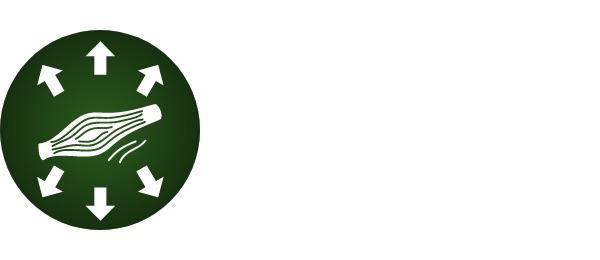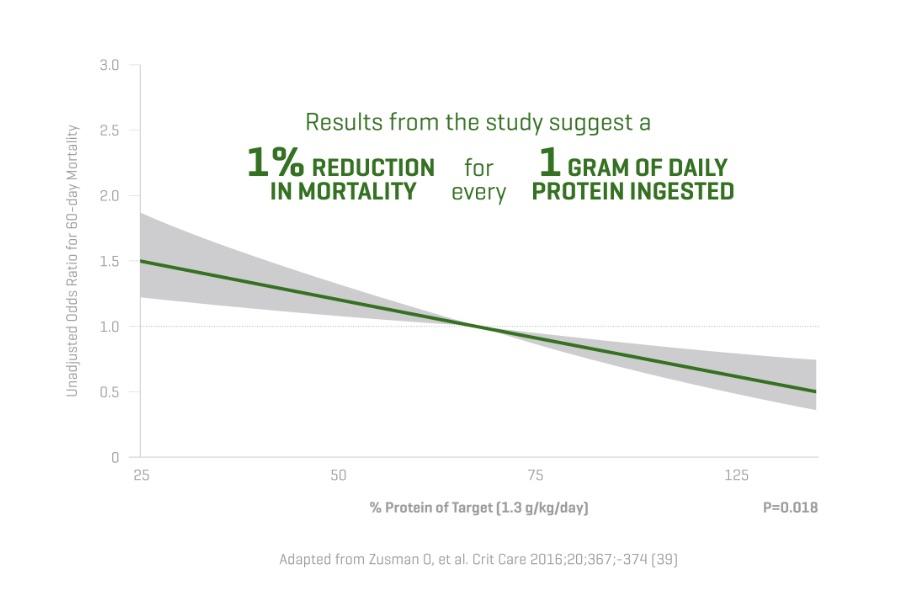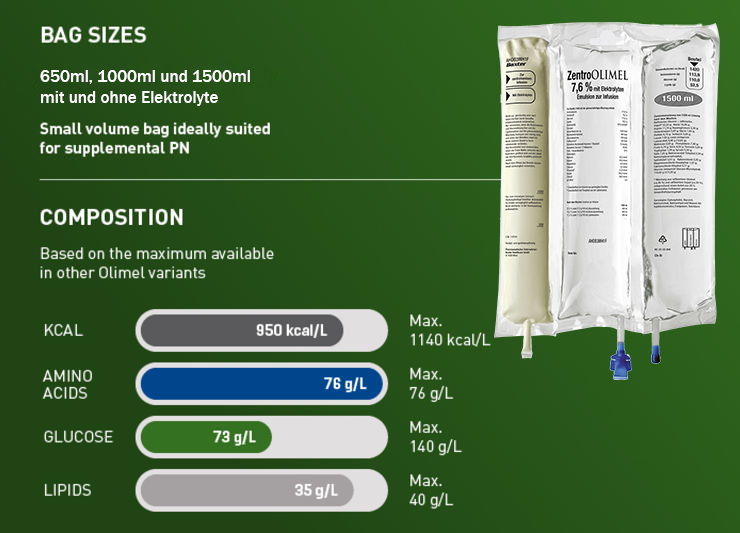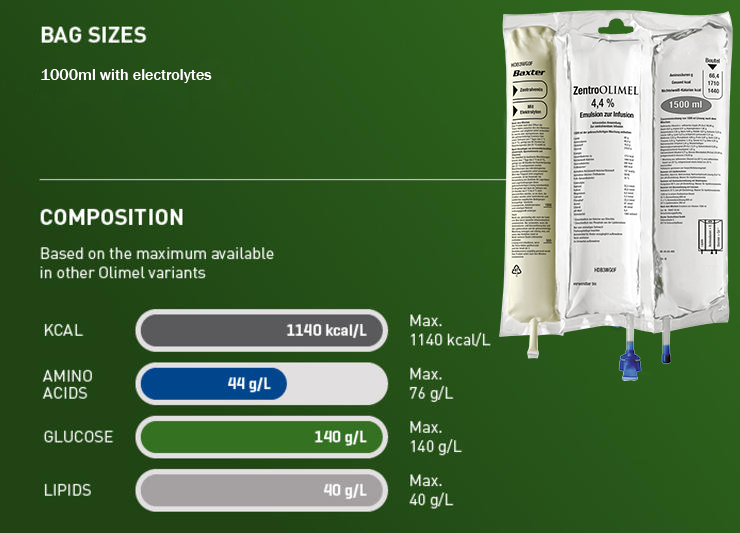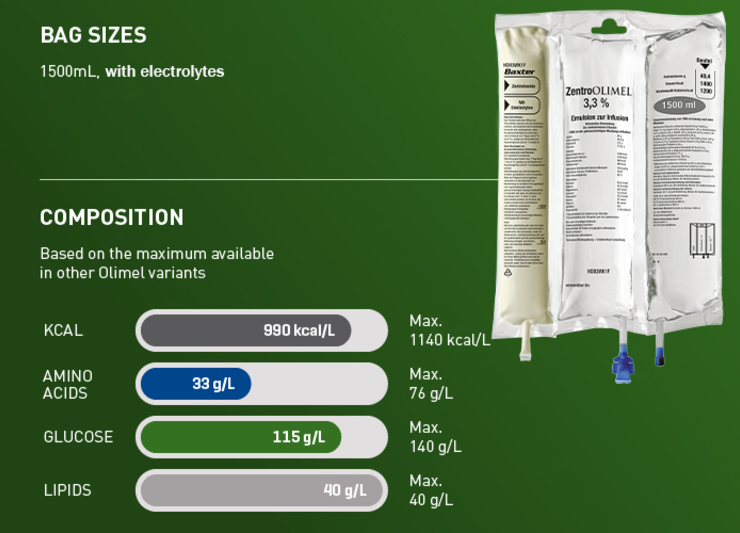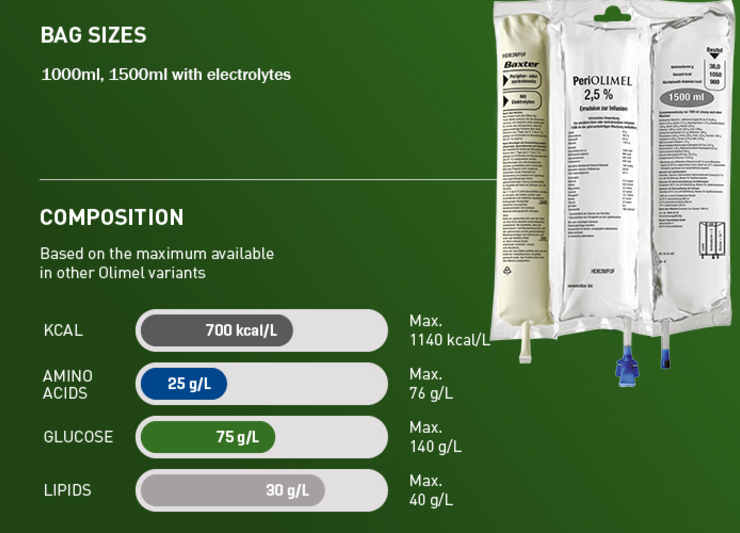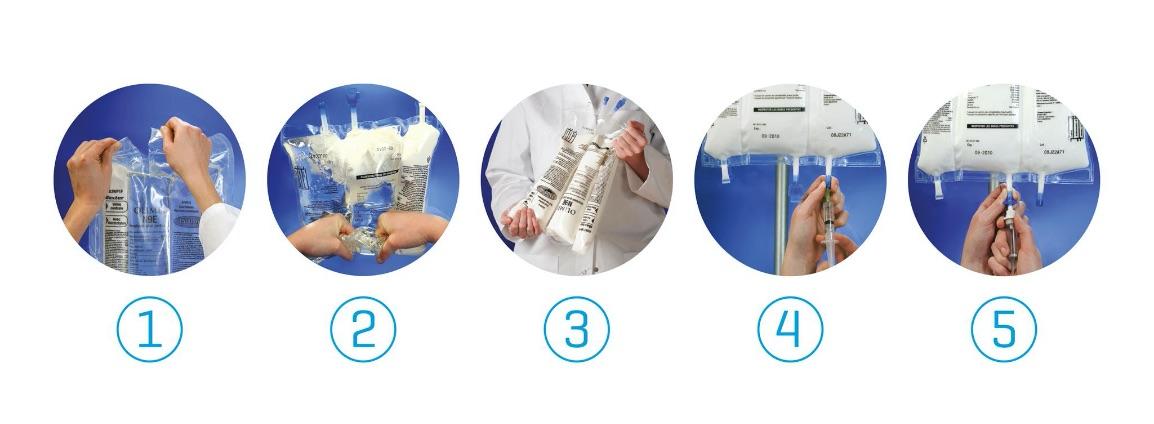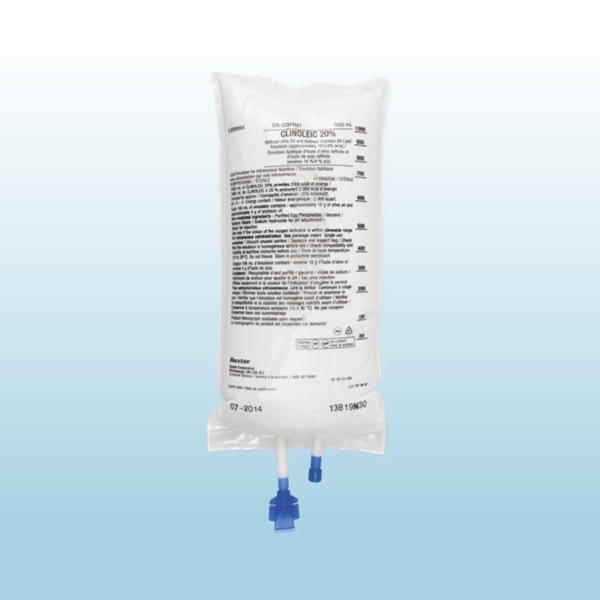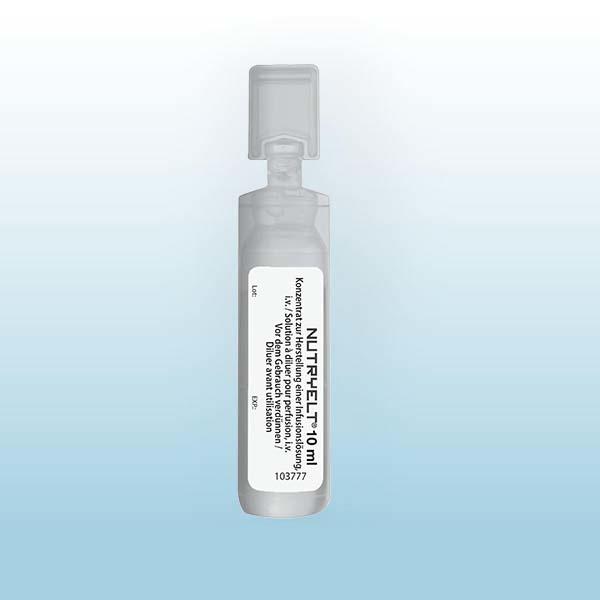Important safety information
Peri/ZentroOLIMEL
Bezeichnung: PeriOLIMEL 2,5 % mit Elektrolyten – Emulsion zur Infusion // ZentroOLIMEL 3,3 % / 4,4 % / 5,7 % / 7,6% mit Elektrolyten – Emulsion zur Infusion // 5,7 % / 7,6% - Emulsion zur Infusion.
Pharmakotherapeutische Gruppe: Lösungen zur parenteralen Ernährung / Kombinationen. ATC-Code: B05 BA10.
Qualitative und Quantitative Zusammensetzung: PeriOLIMEL, ZentroOLIMEL 3,3 %, 4,4%, 5,7%, 7,6% mit Elektrolyten, ZentroOLIMEL 5,7 %, 7,6% wird in einem Dreikammer-Beutel geliefert. Jeder Beutel enthält eine Glucoselösung (mit Calcium), eine Lipidemulsion und eine Aminosäurenlösung (mit anderen Elektrolyten).
Wirkstoffe: 1.500 ml gebrauchsfertige Emulsion enthalten: Raffiniertes Olivenöl + raffiniertes Sojaöl(a) 45//60/60/60/52,5//60/52,5 g, Alanin 5,50//7,14/9,61/12,36/16,48//12,36/16,48 g, Arginin 3,72//4,84/6,51/8,37/11,16//8,37/11,16 g, Asparaginsäure 1,10//1,43/1,92/2,47/3,3//2,47/3,3 g, Glutaminsäure 1,90//2,47/3,32/4,27/5,69//4,27 /5,69g, Glycin 2,63//3,42/4,60/5,92/7,9//5,92 /7,9g, Histidin 2,26//2,95/3,97/5,09/6,79//5,09/6,79 g, Isoleucin 1,90//2,47/3,32/4,27/5,69//4,27/5,69 g, Leucin 2,63//3,42/4,60/5,92/7,9//5,92/6,79/7,9 g, Lysin (entspricht Lysinacetat) 2,99 // 3,88 / 5,23 / 6,72/8,96 // 6,72 /8,96 g (4,21 // 5,48 / 7,31 / 9,48/12,64 // 9,48/12,64 g), Methionin 1,90//2,47/3,32/4,27/5,69//4,27 /5,69g, Phenylalanin 2,63//3,42/4,60/5,92/7,96//5,92/7,96 g, Prolin 2,26//2,95/3,97/5,09/6,79//5,09/6,79 g, Serin 1,50//1,95/2,62/3,37/4,50//3,37/4,50 g, Threonin 1,90//2,47/3,32/4,27/5,69//4,27/5,69 g, Tryptophan 0,64//0,82/1,10/1,42/1,90//1,42/1,90 g, Tyrosin 0,10//0,13/0,17/0,22/0,30//0,22/0,30 g, Valin 2,43//3,16/4,25/5,47/7,29//5,47/7,29 g, Natriumacetat-Trihydrat 1,73//2,24/2,24/2,24/2,24//- g/-g,
Natriumglycerophosphat, hydratisiert 2,87//5,51/5,51/5,51/5,51//-g/-g, Kaliumchlorid 1,79//3,35/3,35/3,35/3,35//- g/-g, Magnesiumchlorid-Hexahydrat 0,67//1,22/1,22/1,22/1,22//- g/-g, Calciumchlorid-Dihydrat 0,44//0,77/0,77/0,77/0,77//- g/-g, Glucose (entspricht Glucose-Monohydrat) 112,50 // 172,50 / 210,00 / 165,00/110,00 // 165,00/110,00 g (123,75 // 189,75 / 231,00 / 181,50/121,00 // 181,50/121,00 g). (a) Mischung aus raffiniertem Olivenöl (ca. 80 %) und raffiniertem Sojaöl (ca. 20 %), entsprechend einem Anteil von 20 % essenziellen Fettsäuren gemessen am Gesamtfettsäurengehalt.
Nährstoffzufuhr der gebrauchsfertigen Emulsion: 1.500ml enthalten: Lipide: 45//60/60/60/52,5//60/52,5g; Aminosäuren: 38//49,4/66,4/85,4/113,9//85,4/113,9g; Stickstoff: 6,0//7,8/10,5/13,5/18,0//13,5/18,0g;Glucose: 112,5//172,5/210,0/165,0/110//165,0/110g; Energie: Gesamtkalorien ca. 1050//1490/1750/1600/1420//1600/1420kcal; Nichteiweiß-Kalorien ca. 900//1290/1440/1260/960//1260/960 kcal; Glucosekalorien: 450//690/840/660/430//660/430kcal; Fettkalorien ca.(a) 450//600/600/600/520//600/520kcal; Verhältnis Nichteiweiß Kalorien/Stickstoff: 150//165/127/93/53//93/53kcal/g; Verhältnis Glucose-/Fettkalorien: 50/50 // 53/47 / 58/42 / 52/48 /45/55 // 52/48/45/55; Fett-/Gesamtkalorien: 43//47/35/37/37//37/37%; Elektrolyte: Natrium: 31,5//52,5/52,5/52,5/52,5//-/- mmol; Kalium: 24//45/45/45/45//-/- mmol; Magnesium: 3,3//6/6/6/6//-/- mmol; Calcium: 3//5,3/5,3/5,3/5,3//-/- mmol;Phosphat(b): 12,7//22,5/22,5/22,5/21,9//4,5/3,9 mmol; Acetat: 41//55/67/80/105//60/80 mmol; Chlorid: 37//68/68/68/68//- mmol; pH-Wert ca. 6,4; Osmolarität ca. 760//1120/1360/1310/1270//1170/1130 mOsm/l. (a)Einschließlich der Kalorien aus gereinigten Phospholipiden aus Eiern (b)Einschließlich des Phosphats aus der Lipidemulsion.
Liste der sonstigen Bestandteile: Kammer mit Lipidemulsion: Gereinigte Phospholipide aus Eiern, Glycerol, Natriumoleat, Natriumhydroxid (zur pH-Einstellung), Wasser für Injektionszwecke. Kammer mit Aminosäurenlösung mit Elektrolyten: Essigsäure (zur pH-Einstellung), Wasser für Injektionszwecke. Kammer mit Glucoselösung mit Calcium: Salzsäure (zur pH-Einstellung), Wasser für Injektionszwecke.
Anwendungsgebiete: PeriOLIMEL 2,5%, ZentroOLIMEL 3,3 %, 4,4%, 5,7%, 7,6% mit Elektrolyten, ZentroOLIMEL 5,7%, 7,6% wird für die parenterale Ernährung bei Erwachsenen und Kindern über 2 Jahre angewendet, wenn eine orale oder enterale Ernährung nicht möglich, unzureichend oder kontraindiziert ist.
Gegenanzeigen: Die Anwendung von PeriOLIMEL, ZentroOLIMEL mit Elektrolyten ist kontraindiziert bei: Frühgeborenen, Neugeborenen und Kindern unter 2 Jahren / Überempfindlichkeit gegen Ei, Soja, Erdnussproteine oder Mais/Maisprodukte (siehe Abschnitt 4.4) oder einen der Wirkstoffe oder einen der in Abschnitt 6.1 genannten sonstigen Bestandteile / Angeborenen Störungen des Aminosäurenstoffwechsels / Schwerer Hyperlipidämie oder schweren Störungen des Lipidmetabolismus, gekennzeichnet durch Hypertriglyceridämie / Schwerer Hyperglykämie / Pathologisch erhöhten Natrium-, Kalium-, Magnesium-, Calcium- und/oder Phosphatkonzentrationen im Plasma. (gilt nur für PeriOLIMEL, ZentroOLIMEL 3,3 %, 4,4%, 5,7 %, 7,6% mit Elektrolyten) Inhaber der Zulassung: Baxter Healthcare GmbH, A-1020 Wien Stand der Information: März 2020 Verschreibungspflicht/Apothekenpflicht: Rezept- und apothekenpflichtig.
Weitere Angaben zu “Besondere Warnhinweise und Vorsichtsmaßnahmen für die Anwendung“, „Wechselwirkungen mit anderen Arzneimitteln und sonstige Wechselwirkungen“, „Fertilität, Schwangerschaft und Stillzeit“ und „Nebenwirkungen“ sind der veröffentlichten Fachinformation zu entnehmen.


